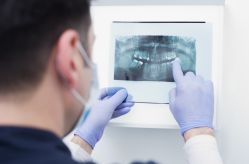
Dental cavities are common issues that most people experience at some point in their lives. However, many people don’t realize they have cavities since they start quite small. Learn more about how to detect this issue, and how your dentist can help, below.
How to Tell When You Have a Cavity
1. Discoloration
Cavities form when bacteria present in the mouth emit acids that erode the teeth. When this happens, your dental enamel may develop white patches, which can then shift into shades of brown, green, or black. Anytime you have discoloration on the surface of your teeth, talk with your dentist.
2. A Hole or Pit

Over time, the erosion can lead to a hole in your tooth. As the bacteria continue to travel deeper, they can create a pathway for other bacteria to enter, causing painful infections. Cavities can also harbor food particles or bacterial colonies, making the decay progress faster. Fortunately, dentists can spot decay on X-rays, allowing them to quickly and easily remove the damaged portions of the tooth and fill them with amalgam or composite resin.
3. Sensitivity
When a cavity burrows deep into your tooth, it can eventually access the nerves and blood vessels, causing pain and sensitivity. If you've noticed a stinging or aching feeling when you drink hot or cold liquids or consume foods with high sugar levels, it could be a sign that you have a cavity.
If you suspect that you have a cavity, turn to Chinook Family Dentistry in Anchorage, AK. With a friendly team and an office that’s warm and inviting, these professionals can help you to feel comfortable while you correct any dental discomfort you have. Learn more about their state-of-the-art dental equipment by visiting their website, or call (907) 272-8422 to schedule an appointment.
About the Business
Have a question? Ask the experts!
Send your question

